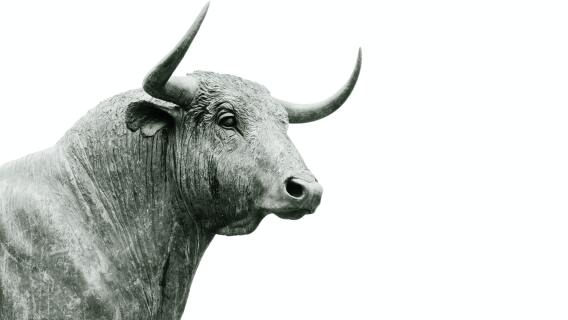After a somewhat shaky start to the year with a fair amount of chop in the major indexes, investors may be wondering whether we’re still in a bull market.
Thankfully, we are.
The recent sideways trading may not be as euphoric as the first two years of this bull run, but the markets are still perched near all-time highs, a far sight from the 20% declines that would be needed to mark the arrival of a bear market.
More importantly, we’re still in the midst of a very young bull market.
At 26 months (since October of 2022), we’ve only recently surpassed the shortest bull market in history (21 months).
The average bull market, for comparison, lasts about 61 months.
The average bear market, on the other hand, lasts about nine and a half months, which is exactly what we saw with the bear market that began at the end of 2021 and ran through mid-October of 2022.
Over a long enough period (say the years captured by this 100-year chart), the U.S. stock markets perpetually lean bullish.
The bullish lean comes from a combination of economic growth, productivity gains, modest inflation, and a healthy market full of companies that operate with world-leading transparency and attract global capital.
Even considering the impact of the pandemic crash, the Great Recession, the dot com bubble, Black Monday, the Nifty Fifty, etc., long-term investors have enjoyed significant returns over the decades.




So, why does it matter whether we’re in a bull or a bear market?
Well, that depends on your investing style.
Why It Matters Whether It’s a Bull or Bear Market
Let’s take a look at two investing styles (momentum investing and longer-term investing) and break down the impacts of a bull or bear market on each and how much it matters to those investors.
If you’re a long-term investor who uses strategies like dollar-cost averaging, 401(k) investing, or buy-and-hold investing in assets like mutual funds or ETFs, the effect of the state of the market is highly dependent on where you are in your investing journey.
A Bull or Bear Market Doesn’t Matter if…
You’re still early in your investing journey.
For example, if you invested in the S&P 500 ETF (SPY) in July of 2000, just before the dot com bubble burst, your initial investment would have gotten back to even sometime around the middle of 2007…
…which would have put you right at the market peak before the Great Recession…
…at which point, it would have taken another six years (until mid-2013) for you to get back to breakeven.
But, and this is a big but, if you had simply held your investment through all of that (including the pandemic mini-crash and 2022’s bear market), you’d be up over 368% today.
That breaks down to an annual return of 6.5%.
Now, if you had reinvested dividends the whole time, you would have enjoyed 7.7% annual returns, which would translate to a total return of 525%.
All of that assumes you had just invested a single lump sum at one of the worst times to do so ever.
If you were regularly investing, such as through a 401(k) or simply recurring buys over the last 24 years, your returns would have been about 9.7% each year.
For example, a $10,000 investment in July of 2000 plus an additional $100 investment every month, just in the S&P 500, would be worth $208,500 today.
That’s a total investment ($10,000 plus $100/month) of only $39,400 that’s now worth nearly a quarter of a million dollars.
Now, what if you had held off on investing and waited until July of 2001 after the market had lost 20% in a year?
In that case, your total investment of $38,200 (one year less of monthly contributions) would be worth $210,700 today, which translates to a 10.3% annual return.
Good timing would have translated to a difference of about $2,200 over the course of 24 years. (If you’re interested in playing with the timing of the scenario, this S&P 500 DCA calculator is a useful tool.)
Corrections, crashes and bear markets are inevitable, but if you’ve got a long enough time horizon, the historical returns more than make up for the brief drops.
A Bull or Bear Market Matters Most if…
You’re approaching retirement or you are a momentum investor.
If you’re approaching retirement, the biggest risk from a bear market is that you see short-term declines in market values at a point when you need to sell assets to draw down your accounts to fund your retirement.
This is a major reason why many financial advisors recommend that investors put less money into stocks and more money into assets like bonds or cash as they get older.
Selling into a bear market is basically the opposite of dollar-cost averaging (the source of those gains above), plus, once you’re no longer working you cannot replace retirement assets.
One caveat: if you are drawing a pension or are not relying on your stocks and ETFs to fund your retirement, you can afford to keep more money in stocks to build legacy wealth (money to be handed off to charities or passed down to your heirs) because you won’t be forced to sell into the aforementioned bear market.
So, if you’re worried about a possible bear market and are approaching the retirement finish line, consider building up a buffer in cash, bonds or other more conservative assets.
Whether we’re in a bull market or a bear market is also very important for momentum investors.
If you’re investing in high-growth momentum stocks, it’s far simpler (and more profitable) in a bull market.
In a bull market, the market’s primary trend (rising) is a tailwind for your investments. In a bear market, on the other hand, the primary trend (falling) is a tide that your portfolio is swimming against.
Ideally, momentum traders should be identifying stocks that are in an uptrend with a bullish market adding wind to their sails.
When you’re trading momentum stocks in a bear market, you need to be far more discerning in picking out the clear leaders; only the strongest swimmers can fight that bearish tide.
Cabot Top Ten Trader can help you identify the best stocks in both conditions, and if you’re a momentum trader, right now, the wind is at your back.

Sign up now!

Sign up now!

Sign up now!

Sign up now!

